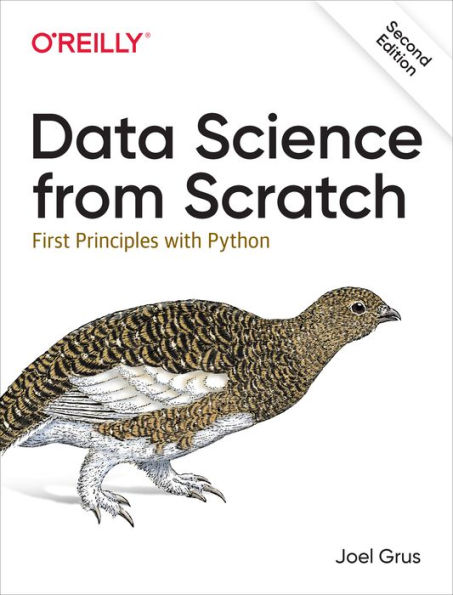Table of Contents
Preface xi
1 Introduction 1
The Ascendance of Data 1
What Is Data Science? 1
Motivating Hypothetical: DataSciencester 2
Finding Key Connectors 3
Data Scientists You May Know 6
Salaries and Experience 8
Paid Accounts 11
Topics of Interest 11
Onward 13
2 A Crash Course in Python 15
The Basics 15
Getting Python 15
The Zen of Python 16
Whitespace Formatting 16
Modules 17
Arithmetic 18
Functions 18
Strings 19
Exceptions 19
Lists 20
Tuples 21
Dictionaries 21
Sets 24
Control Flow 25
Truthiness 25
The Not-So-Basics 26
Sorting 27
List Comprehensions 27
Generators and Iterators 28
Randomness 29
Regular Expressions 30
Object-Oriented Programming 30
Functional Tools 31
Enumerate 32
Zip and Argument Unpacking 33
Args and kwargs 34
Welcome to DataSciencester! 35
For Further Exploration 35
3 Visualizing Data 37
Matplotlib 37
Bar Charts 39
Line Charts 43
Scatterplots 44
For Further Exploration 47
4 Linear Algebra 49
Vectors 49
Matrices 53
For Further Exploration 55
5 Statistics 57
Describing a Single Set of Data 57
Central Tendencies 59
Dispersion 61
Correlation 62
Simpsons Paradox 65
Some Other Correlational Caveats 66
Correlation and Causation 67
For Further Exploration 68
6 Probability 69
Dependence and Independence 69
Conditional Probability 70
Bayes's Theorem 72
Random Variables 73
Continuous Distributions 74
The Normal Distribution 75
The Central Limit Theorem 78
For Further Exploration 80
7 Hypothesis and Inference 81
Statistical Hypothesis Testing 81
Example: Flipping a Coin 81
Confidence Intervals 85
P-hacking 86
Example: Running an A/B Test 87
Bayesian Inference 88
For Further Exploration 92
8 Gradient Descent 93
The Idea Behind Gradient Descent 93
Estimating the Gradient 94
Using the Gradient 97
Choosing the Right Step Size 97
Putting It AH Together 98
Stochastic Gradient Descent 99
For Further Exploration 100
9 Getting Data 103
Stdin and stdout 103
Reading Files 105
The Basics of Text Files 105
Delimited Files 106
Scraping the Web 108
HTML and the Parsing Thereof 108
Example: O'Reilly Books About Data 110
Using APIs 114
JSON (and XML) 114
Using an Unauthenticated API 115
Finding APIs 116
Example: Using the Twitter APIs 117
Getting Credentials 117
For Further Exploration 120
10 Working with Data 121
Exploring Your Data 121
Exploring One-Dimensional Data 121
Two Dimensions 123
Many Dimensions 125
Cleaning and Munging 127
Manipulating Data 129
Rescaling 132
Dimensionality Reduction 134
For Further Exploration 139
11 Machine Learning 141
Modeling 141
What Is Machine Learning? 142
Overfitting and Underfitting 142
Correctness 145
The Bias-Variance Trade-off 147
Feature Extraction and Selection 148
For Further Exploration 150
12 k-Nearest Neighbors 151
The Model 151
Example: Favorite Languages 153
The Curse of Dimensionality 156
For Further Exploration 163
13 Naive Bayes 165
A Really Dumb Spam Filter 165
A More Sophisticated Spam Filter 166
Implementation 168
Testing Our Model 169
For Further Exploration 172
14 Simple Linear Regression 173
The Mode! 173
Using Gradient Descent 176
Maximum Likelihood Estimation 177
For Further Exploration 177
15 Multiple Regression 179
The Model 179
Further Assumptions of the Least Squares Model 180
Fitting the Model 181
Interpreting the Model 182
Goodness of Fit 183
Digression: The Bootstrap 183
Standard Errors of Regression Coefficients 184
Regularization 186
For Further Exploration 188
16 Logistic Regression 189
The Problem 189
The Logistic Function 192
Applying the Model 194
Goodness of Fit 195
Support Vector Machines 196
For Further Investigation 200
17 Decision Trees 201
What Is a Decision Tree? 201
Entropy 203
The Entropy of a Partition 205
Creating a Decision Tree 206
Putting It All Together 208
Random Forests 211
For Further Exploration 212
18 Neural Networks 213
Perceptrons 213
Feed-Forward Neural Networks 215
Backpropagation 218
Example: Defeating a CAPTCHA 219
For Further Exploration 224
19 Clustering 225
The Idea 225
The Model 226
Example: Meetups 227
Choosing k 230
Example: Clustering Colors 231
Bottom-up Hierarchical Clustering 233
For Further Exploration 238
20 Natural Language Processing 239
Word Clouds 239
n-gram Models 241
Grammars 244
An Aside: Gibbs Sampling 246
Topic Modeling 247
For Further Exploration 253
21 Network Analysis 255
Betweenness Centrality 255
Eigenvector Centrality 260
Matrix Multiplication 260
Centrality 262
Directed Graphs and PageRank 264
For Further Exploration 266
22 Recommender Systems 267
Manual Curation 268
Recommending What's Popular 268
User-Based Collaborative Filtering 269
Item-Based Collaborative Filtering 272
For Further Exploration 274
23 Databases and SQL 275
Create Table and Insert 275
Update 277
Delete 278
Select 278
Group By 280
Order By 282
Join 283
Subqueries 285
Indexes 285
Query Optimization 286
NoSQL 287
For Further Exploration 287
24 MapReduce 289
Example: Word Count 289
WhyMapReduce? 291
MapReduce More Generally 292
Example: Analyzing Status Updates 293
Example: Matrix Multiplication 294
An Aside: Combiners 296
For Further Exploration 296
25 Go Forth and Do Data Science 299
IPython 299
Mathematics 300
Not from Scratch 300
NumPy 301
Pandas 301
Scikit-learn 301
Visualization 301
R 302
Find Data 302
Do Data Science 303
Hacker News 303
Fire Trucks 303
T-shirts 304
And You? 304
Index 305



